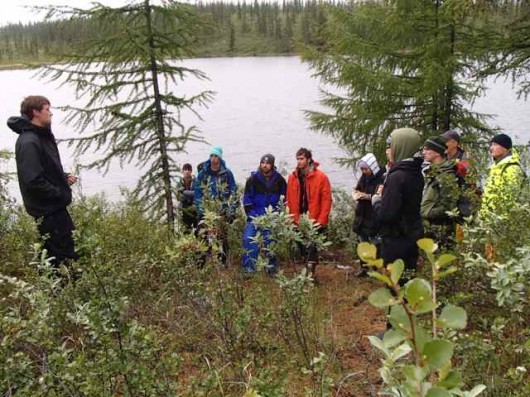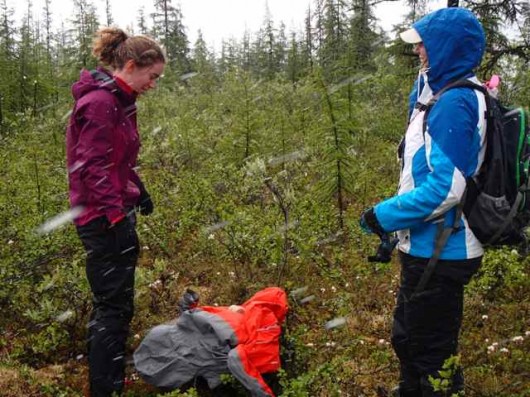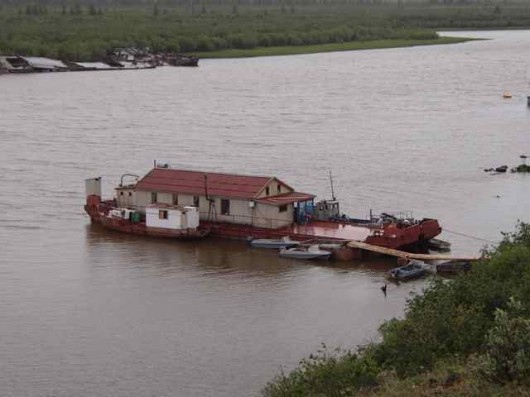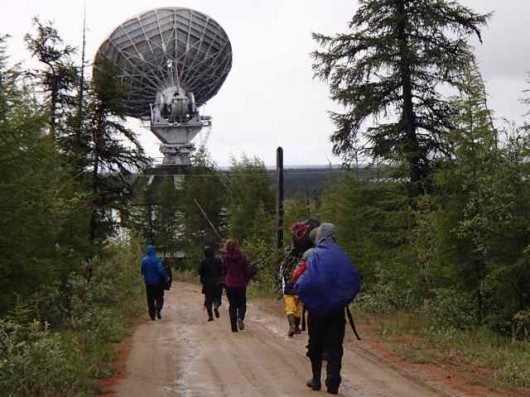(This post is by Mark Paricio, a PolarTREC teacher accompanying the Polaris Project this year.
To read all of Mark’s posts, go to: http://www.polartrec.com/expeditions/siberian-arctic-systems-study )
Since we arrived a day later than expected, we needed to work especially hard to make up for lost time at our new home near Cherskiy. This morning, a combination of cold and snow could not hamper the work needing to be done. A favorite saying of my family in the Colorado high country definitely applied to our efforts today:
If it doesn’t snow on you in July, then you’re just not trying.
It definitely did snow on us today and we were definitely working hard. In the morning, I accompanied undergraduate students Ludda Ludwig (St. Olaf College), Vavara Andreeva (Northeast Federal University in Yakutsk), Lindsey Parkinson (Western Washington University), Dylan Broderick (Clark University), Eric Taber (Colgate College), Brandi Jo Petronio (University of Florida), and Peter Ganzlan (a research assistant) for several hours to gather tree and shrub fuel in the forest for an experimental burn later in the week. It was hard work, interrupted by blowing snow at times – but we preferred the snow to the mosquitoes!
Where We Will Live
Our group, being the largest contingent the Polaris Project has ever brought to the Northeast Science Station (NESS), was split into two areas for our stay. The first time undergraduates and a few advisors are staying on “The Barge” – a converted river barge on which has become essentially a wooden cabin dormitory.
The returning undergraduate students, graduate students, advisors, and assorted visitors, such as myself, are staying in the “Orbita” – a Soviet era concrete communications station with a gigantic satellite dish on top.
The Science Begins Quickly
After arriving yesterday afternoon in Cherskiy, we wasted no time getting to work, preparing for the research projects that will be taking place over the next month.
As the permafrost soils in the Kolyma River Basin contain a similar amount of carbon as all of the vegetation on the earth, it is essential to determine how the permafrost will behave as the temperatures of the planet increase. Since the carbon in permafrost soils was deposited as organic materials between 50,000 to 10,000 years ago (in the Pleistocene e ra) and has been frozen in place since then, it is often referred to as “old carbon.” This is different from “new carbon”, carbon in the upper layer of soil that comes from the deposit of more recent organic materials. This new soil freezes in the winter but thaws in the summer months and is known as the “active layer” in which modern vegetation grows.

Nikita Zimov of the Northeast Science Station talks to Polaris Project members about the vast quantities of the carbon stored in Siberian permafrost soils.
Because such vast quantities of carbon could be released as greenhouse gasses carbon dioxide or methane by increasing temperatures, both the scientists and the science students of the Polaris Project will be conducting experiments designed to investigate the fate of this “old carbon” on our warming earth. These experiments can be divided roughly into two categories: terrestrial and aquatic.
Terrestrial research investigates the fate of the carbon in permafrost soils on land due to a variety of disturbances. One of the experiments being conducted by Polaris Project scientist Dr. Heather Alexander of the University of Texas Brownsville involves the influence of fire in the Siberian boreal forests on permafrost soils. This is the experiment for which we gathered fuel from the forest this morning. I will give more information on Heather’s experiment over the next few weeks.
Aquatic research seeks to understand the transport and transformation of the old carbon through waterways to the sea, to the atmosphere, or to deposition into sediments. One can think of the carbon that is dissolved in the dark Siberian rivers as “nature’s tea,” as tea is simply made by dissolving the organic (carbon containing) matter of leaves in water. Polaris Project scientist Dr. Max Holmes of the Woods Hole Research Center and his colleagues have been conducting an ongoing survey of carbon processing and transport (scientists call this “flux”) through the rivers and waterways in the Kolyma River Basin for many years. More details of Max’s experiments will also be discussed in further journals.
Student Projects
One of the goals of the Polaris Project expedition to Siberia is to expose undergraduate students to Arctic science in order to help these students gain research skills, and to provide a mentoring relationship so these students can successfully pursue careers as polar scientists.
Over the next three weeks, the undergraduate Polaris Project students will design and conduct their own scientific projects. After spending a week traveling with these remarkable young people, I look forward to sharing their stories and projects in later journals as well.
Stay curious my friends! – Mark Paricio






